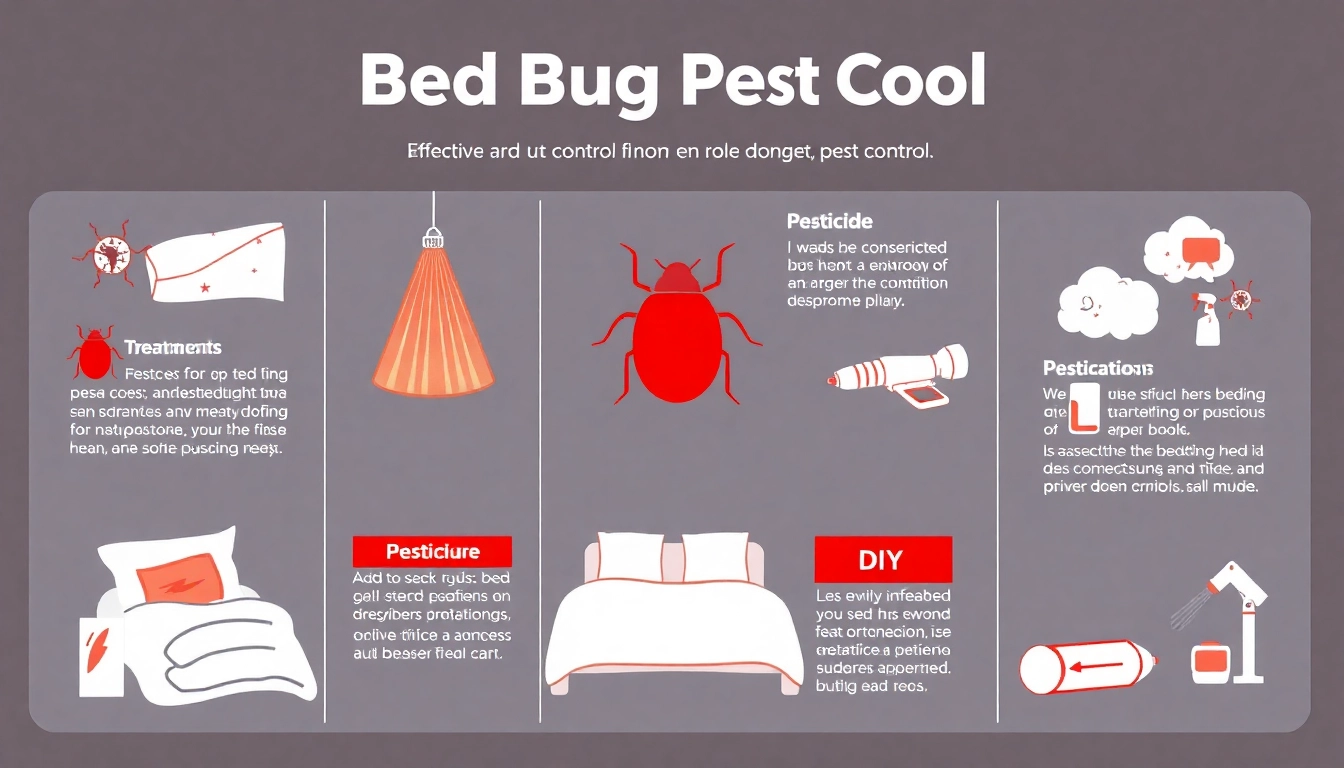Understanding Bed Bugs and Their Habits
What are Bed Bugs?
Bed bugs are small, reddish-brown insects that belong to the family Cimicidae. These nocturnal pests feed primarily on the blood of humans and animals, making them a significant concern in residential and commercial spaces. Despite their name, bed bugs can inhabit a variety of environments, including hotels, public transportation, and houses. Their elusive nature and rapid reproduction make them challenging to eliminate once they establish a foothold. Understanding the behavior and biology of bed bugs is crucial for effective bed bug pest control.
Signs of an Infestation
Identifying a bed bug infestation early can significantly reduce the time and resources needed for control. Common signs include:
- Bitten Skin: Small, red, itchy welts may appear on the skin, often in a linear or clustered formation.
- Live Bugs and Eggs: Adult bed bugs are about the size of an apple seed, while the eggs are tiny and white, often found in crevices.
- Fecal Stains: Dark spots on bedding or furniture can indicate bed bug droppings.
- Exoskeletons: As bed bugs grow, they shed their skins, which can be found near their hiding spots.
Life Cycle of a Bed Bug
The life cycle of a bed bug consists of five development stages, known as instars, before reaching adulthood. Under optimal conditions, bed bugs can reproduce swiftly, with a single female laying hundreds of eggs in her lifetime. Understanding their life cycle is essential for implementing effective pest management strategies.
DIY Bed Bug Pest Control Techniques
Non-Chemical Methods
When addressing a bed bug infestation, many homeowners may initially opt for non-chemical treatments. These methods can be safer for individuals and pets and can be effective when used in conjunction with other strategies. Some notable non-chemical methods include:
- Vacuuming: Use a vacuum with a HEPA filter to remove bed bugs and their eggs from surfaces. Focus on seams, crevices, and under furniture.
- Steam Cleaning: High-temperature steam can penetrate furniture and surfaces, effectively killing bed bugs at all life stages.
- Diatomaceous Earth: This natural powder can be applied to areas where bed bugs are suspected. It works by damaging the insects’ exoskeletons and causing dehydration.
Essential Oils and Natural Remedies
While natural remedies are less scientifically validated than commercial products, certain essential oils are believed to have insecticidal properties. For example:
- Tea Tree Oil: This oil has antifungal and antibacterial properties that may aid in repelling bed bugs.
- Lavender Oil: Known for its pleasant fragrance, lavender also acts as a deterrent against insects.
- Peppermint Oil: Its pungent aroma may interfere with bed bug sensing mechanisms.
When using essential oils, ensure they are properly diluted and applied in targeted areas.
Using Heat to Eliminate Bed Bugs
Heat treatment is one of the most effective methods for killing bed bugs. When exposed to temperatures exceeding 120°F (about 49°C) for a sustained period, bed bugs die, including their eggs. Practical applications of heat treatment include:
- Washing and Drying: Washing clothes and bedding in hot water, followed by drying on high heat, can eliminate any bed bugs present.
- Heat Chambers: Professional pest control services often utilize specialized equipment that heats entire rooms or specific items to lethal temperatures.
Professional Bed Bug Extermination Services
Choosing the Right Pest Control Company
When DIY methods are insufficient or an infestation is severe, hiring a professional extermination service may be necessary. Factors to consider when selecting a pest control company include:
- Experience and Certifications: Opt for companies with a proven track record and certified pest control professionals.
- Integrated Pest Management (IPM) Approach: Companies that utilize IPM consider multiple pest management strategies, including environmentally safe options.
- Guarantees and Follow-Up Services: Look for services that offer post-treatment guarantees and follow-up inspections to ensure the infestation is fully resolved.
Common Treatment Options
Professional pest control companies employ a variety of treatment methods to combat bed bugs. Some of the most commonly used include:
- Chemical Treatments: Pesticides specifically designed for bed bug control are applied to infested areas. These products may come in the form of sprays, dusts, or baits.
- Heat Treatments: As mentioned, this method utilizes high temperatures to eradicate bed bugs across all life stages.
- Vacuuming and Steam Cleaning: Professionals often utilize specialized equipment to thoroughly clean and sanitize infested areas.
What to Expect During Professional Treatment
Professional bed bug treatments typically involve a multi-step process:
- Inspection: A thorough examination of the premises to identify the extent of the infestation.
- Treatment: Application of the selected pest control methods, which may take several hours.
- Follow-Up: Scheduling follow-up visits to ensure the effectiveness of the treatment and address any remaining issues.
Cost of Bed Bug Pest Control
Factors Influencing Treatment Costs
The cost of bed bug pest control can vary significantly based on several factors:
- Extent of the Infestation: Larger or more severe infestations typically require more extensive treatment efforts.
- Type of Treatment Chosen: Heat treatments often cost more than chemical treatments but may be more effective.
- Location: Geographical differences can influence costs, with urban areas generally experiencing higher prices.
Budget-Friendly Solutions
For those on a budget, consider the following tips for managing costs associated with bed bug control:
- DIY Approaches: For minor infestations, utilizing the DIY methods discussed earlier can reduce costs significantly.
- Early Detection: Addressing an infestation early can minimize treatment complexity and costs.
- Regular Maintenance: Engage in preventative practices that may minimize the chances of recurrence, saving future costs.
Insurance and Coverage Options
In some cases, homeowner’s insurance may cover bed bug treatments. Review your policy and consult with your insurance provider for details regarding coverage and potential reimbursement options. It’s essential to document infestations and treatments to facilitate claims.
Preventing Future Bed Bug Infestations
Best Practices for Prevention
Preventing bed bug infestations is key to maintaining a pest-free environment. Implement these best practices:
- Regular Cleaning: Keep living areas tidy, perform regular vacuuming, and avoid clutter that can harbor pests.
- Protective Covers: Encase mattresses and box springs with bed bug-proof covers to limit access.
- Mindful Travel: When traveling, inspect hotel rooms and keep luggage off the floor and bed.
Regular Inspections and Maintenance
Incorporate regular inspections into your cleaning routine. By checking for signs of bed bugs periodically, you can catch infestations early before they worsen. Engaging pest control experts for annual inspections can also help keep your space pest-free.
Travel Tips to Avoid Bed Bugs
Travel is a common way for bed bugs to spread from one location to another. Here are tips to minimize risk while traveling:
- Inspect Hotel Rooms: Check the mattress seams, headboard, and furniture for any signs of bed bugs.
- Keep Luggage Elevated: Use luggage racks instead of placing bags directly on the bed or floor.
- Wash Clothes Promptly: Upon returning home, wash and dry your clothes on high heat to eliminate any potential hitchhikers.



